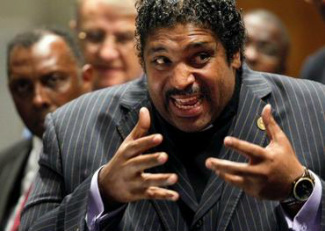 Reverend Dr. William J. Barber Reverend Dr. William J. Barber Tags: crime/law/deviance, discourse/language, goffman, government/the state, inequality, knowledge, lgbtq, prejudice/discrimination, social mvmts/social change/resistance, theory, civil unions, collective action frames, marriage equality, same-sex marriage, 00 to 05 mins Year: 2011 Length: 4:24 Access: YouTube Summary: In previous posts on The Sociological Cinema, we have explored Erving Goffman's concept of framing (here, here, and here). To recap, the concept has been useful for scholars of social movements, who have rebranded the term collective action framing. The concept denotes the active and processual sense-making and signification of phenomena done by social actors. In other words, the realization that a conflict with police is evidence of a repressive state and that the passage of a new law is an effort to codify division and discrimination are socially "made" interpretations or meanings. They are the social achievements sociologists refer to as frames. The success then of passing a new law or amending an old one often hinges on how the proposed change is framed for the public and how influential that particular frame is in shaping the terms of the debate. The above clip is a speech from Reverend Dr. William J. Barber. who rebukes the media for using the "wrong" frame to report on the recent amendment to North Carolina's state constitution, which passed on May 8, 2012 and defines marriage as between one man and one woman. The amendment also bans any other type of "domestic legal union," such as civil unions and domestic partnerships. Barber asserts that the media frequently polled the public asking, "How do you feel about same-sex marriage?" but a better question—a better frame—would have been whether a majority should be able to decide on the rights of a minority, or should discrimination should be written into the constitution? Here Barber is clearly attempting to key the struggle against Amendment One to the protests of the Civil Rights Era, and he even mentions the Voting Rights Act of 1965 by name. In Part II, we'll move beyond framing and explore how this video can be used to illustrate insights from intersectionality theory, a theory that offers promise in overcoming the divisions of identity politics. Submitted By: Lester Andrist
2 Comments
Manuel Franco
7/30/2023 11:57:15 am
I just want to say Thank You to everyone who supported me through the years. My name is Manuel Franco, New Berlin, Wisconsin. My story of how I won the Powerball lottery of $768.4M is a bit of a tale. I have been playing Powerball tickets for 6 years now since I turned 18. I bought my first ticket on my 18 birthday. I was feeling very lucky that day because I had contacted Dr. Odunga Michael to help me with the winning Powerball numbers. I really had that great great feeling that I looked at the camera wanting to wink at it. I only did a tiny part of it and trusted him. He gave me the numbers after I played a couple other tickets along with it for $10. I checked my ticket after the winnings came online and saw the numbers were correct including the Power play. I screamed for about 10 minutes because it felt like a dream. I had won $768.4M. You can check my winning testimony with the lottery officials just with my name search. Thank you Dr Odunga. Well, his email is [email protected] and you can also call or Whats-app him at +2348167159012 so you guys can contact him
Reply
mark hold
7/8/2024 07:50:47 am
Herbal Penis Enlargement product is 100% guaranteed to Enlarge and get a better ERECTION, the reason why most people are finding it difficult to enlarge Penis is that they believe in medical reports, drugs and medical treatment which is not helpful for Penis Enlargement. Natural roots/herbs are the best remedies which can easily Enlarge your Penis permanently Contact Dr MOSES BUBA via Email: [email protected] or via WhatsApp: +2349060529305. for Natural root and herbal remedies put together to help Enlarge manhood and Erect healthily. I also learn that Dr MOSES BUBA also can cure other types of diseases, HEPATITIS B,DIABETICS,CANCER,HPV,LOW SPERM CAM, HIV/STDS, FIBROSIS LOST OF WEIGHT, BREAST ENLARGEMENT, HIPS and BUMS ENLARGEMENT etc .
Reply
Leave a Reply. |
Tags
All
.
Got any videos?
Are you finding useful videos for your classes? Do you have good videos you use in your own classes? Please consider submitting your videos here and helping us build our database!
|
 RSS Feed
RSS Feed
